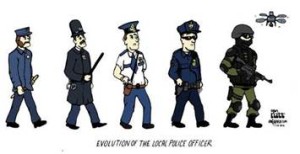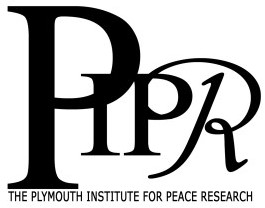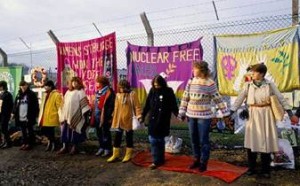‘Enemies of the State’: The War on Activists
By T.J. Coles
1 July 2014
The realisation of the US Defense Department’s quest for Full Spectrum Dominance means exactly what the name of the doctrine implies: no challenge to American elite interests, designed ‘to protect US interests and investment’, will be tolerated.1 By putting weapons in space and using the space medium—satellites for banking, telecoms, internet, etc.—as a tool to assert control, the US will ‘keep those “have-nots” in line’, writes Professor Karl Grossman.2
We should not, however, get confused by the latest gadgetry of coercion. Governments have always considered populations their principal adversaries and have used countless measures—from outright authoritarianism to subtle propaganda—to keep people isolated, afraid, confused, misinformed, and thus helpless. In an era predicted to be one of a ‘widening divide between “haves” and “have-nots”’ (see footnote 1), there will be more activism as people are pushed over the financial edge. Current and future activists need at least an elementary awareness of the techniques used by the State and the corporations to whom it is married in order to survive. Ignorance and naïve trust will cause groups to fail from within.
Agent provocateurs at the G20 protests? https://www.theguardian.com/politics/2009/may/10/g20-policing-agent-provacateurs
POSTWAR ACTIVISM IN THE UK
After World War II, ‘there were never less than a staggering 2 million personal files in MI5s Registry [sic], a number that ‘began to rise dramatically’ in the late 1960s and 1970s’, notes Royal Institute for International Affairs scholar, Professor Michael Clarke.3
In the late-1960s, the Metropolitan Police Special Branch established a Special Demonstration Squad, whose agents infiltrated and subverted antiwar groups (or ‘extremists’, as a BBC article dubs them). ‘Within a few weeks of the 1972 miners’ strike, MI5 shift[ed] emphasis to “domestic subversion”, particularly the “far and wide left”’. The ‘far and wide left’ included communist groups, labour organisations, and peace activists. MI5’s F Branch, which infiltrated and subverted the miners’ unions ‘rapidly expand[ed]’.4
As the miners won small concessions, the State put its anti-activist drive into top gear. Tory MP Jill Knight called trade unions ‘enemies of the state’.5
In the early-1970s, police conspired against builders, notably 31 labourers from North Wales, whom, joining hundreds of others, utilised the picketing tactic to demand higher paid, guaranteed holidays, and tougher health and safety regulations (such as on-site toilets). The so-called Shrewsbury Six (including the now-famous television actor Ricky Tomlinson) went to prison for ‘conspiracy, unlawful assembly and affray’, after being arrested in late-1972, despite the fact that most of the men had never even met prior to their show trial.6
Politicians representing working-class interests were also targeted. MI5 kept a file on the Labour Party leader Harold Wilson in the run-up to the General Election 1974. ‘In his second term as Prime Minister burglaries [we]re carried out against Harold Wilson and his senior staff by MI5’. The organisation amassed 40 volumes on the Labour activist, Jack Jones.7
A former Special Branch officer revealed that Joe Gormley, then-President of the National Union of Miners, was a Special Branch informant during the 1970s. The officer said: ‘The extreme left were getting the upper hand and were dictating the policy of the unions to some great extent’. In a democracy like Britain’s, the will of the people is verboten. BBC reporter Peter Taylor ‘discovered that Special Branch was talking to more than 20 senior trade union leaders during the early 1970s’.8
Another Special Branch officer claimed that the Ford company agreed to invest in Halewood, Merseyside, because of a deal made with MI5 and Special Branch. Former Special Branch officer Tony Robinson said ‘the entire workforce was routinely vetted. Every week Ford would secretly submit a list of the latest job applicants to the local Special Branch’ to see if employees or applicants were activists, unionists, sympathisers, etc.9
INTO THE 1980s
With the planned weaponization of space (Reagan’s ‘Star Wars’) and the further liberalization of investment and liquidity institutions (meaning recession, rising living costs, and falling standards), activism continued into the era of Thatcher.
The Guardian reports that ‘MI5 held files on CND [Campaign for Nuclear Disarmament] leaders during the 1970s and 1980s … It described Bruce Kent, one-time CND chairman, as a “possible Anarchist”’—anarchists were considered ‘subversives’ and thus enemies of the State. The agency ‘also opened a file on Joan Ruddock, the Labour MP who later chaired CND and [became] minister for climate change’. MI5 ‘opened a permanent file on the Greenham Common women’s peace camp’.10
In 1981, the Ministry of Defence established DS19 ‘explicitly to counteract the ‘peace movement’’, writes Professor Michael Clarke. Dr. Eveline Lubbers, a Research Fellow at the University of Bath, writes: ‘Hearings in Parliament questioned the more extreme methods employed, such as the use of death certificates of children that died to provide a false identity for the spies involved’. Lubbers concludes that, ‘using Parliamentary Privilege, Green MP Caroline Lucas has accused one spy of being an agent provocateur; committing arson as a member of the Animal Liberation Front’.11
‘Margaret Thatcher encouraged MI5 to monitor’ the activities and communications of the NUM leadership, ‘notably those of Arthur Scargill and the NUM’s communist vice-president, Mick McGahey’, the Guardian informs us.12
Greenham Common Women’s Peace Camp
In the 1980s, a bugging device was found by workmen at the headquarters of the Communist Party, UK. Around the same time, CND supporter, Madeline Haigh, was visited by an undercover West Midlands Special Branch officer after she wrote a letter to a local newspaper ‘protesting about the cancellation of a peace march’. In 1985, former MI5 agent Cathy Massiter revealed that the National Council for Civil Liberties (now Liberty) and the CND were classified ‘subversive’ organisations by MI5.13
In 1986, an undercover Special Demonstration Squad officer, who had infiltrated Greenpeace London for five years, co-authored a deliberately libellous leaflet about McDonald’s, which led to a lengthy High Court case and drained the resources of an activist group. The author was alleged by a politician to have planted a bomb in Debenhams to frame animal rights groups.14
Six MPs forwarded a motion in the House of Parliament stating that MI5’s F2 Branch, led by Stella Rimington, organised ‘operations against the miners during and after the coal strike of 1984/5’. This included the ‘deployment of agent provocateurs within the National Union of Mineworkers, including Roger Windsor, chief executive officer of the NUM 1983 to 1989’. The motion calls Windsor ‘an agent of MI5 under Mrs. Rimington, sent into the NUM to destabilise and sabotage the union at its most critical juncture’.15
In order to discredit the Union, the motion further states that Windsor raised funds from Muammar Gaddafi in 1984. Windsor cost the NUM £100,000 in libel bills when he apparently forged a letter in the name of David Prendergast of the Union of Democratic Miners. In 1990, ‘under Stella Rimington’s guidance’, Windsor sold a story to Robert Maxwell of the Daily Mirror for £80,000 alleging corruption in the Union, a story ‘that proved to be entirely untrue’.16
The motion says that MI5 ‘has been responsible for the subversion of democratic liberties in Britain’. Tam Dalyell MP told the press that MI5’s F2 Branch ‘was responsible for massive destabilisation which saw the NUM, the trade union’s Brigade Guards, brought to its knees’.17
The Guardian reports that ‘As assistant MI5 director in charge of F2 branch targeting trade unions, Rimington supervised the most ambitious counter-subversion operation ever mounted in Britain’. Notice that working-class people peacefully organising in favour of their rights are called ‘subversives’, yet clandestine and illegal practices by the so-called Secret Service, including forging letters, is called ‘counter-subversion’.18
‘Under her guidance MI5 infiltrated Arthur Scargill’s inner circle, oversaw the country’s largest-ever bugging and telephone-tapping effort in cooperation with GCHQ, coordinated the legal onslaught against the NUM and helped organise the strike-breaking effort’. The Guardian confirms that ‘at least one highly placed source in the NUM national office was feeding Rimington everything from picketing tactics to details of the NUM leader’s private life’.19
In 1986, the BBC reports, ‘Metropolitan Police Special Branch [established] the Animal Rights National Index to collate intelligence gathered by spies on animal liberation groups’.20
INTO THE ’90s & 2000s
The ‘Spirit of the ‘60s’ was partly revived in the late-‘90s in the West, with the growth of anti-World Trade Organization and pro-Green activism.
‘On the eve of the first of six scheduled French nuclear weapons tests in the South Pacific atoll of Mururoa in September [1995], Greenpeace … carried out a series of violent protests’, writes Joseph Brewda for Executive Intelligence Review. ‘A Greenpeace team somehow managed to penetrate the highly militarized nuclear test zone. French authorities revealed that the team was led by two highly trained retired professionals from the British Army’s Special Air Services’.21
In April 1997, Greenham Common peace campaigner Tracy Hart ‘was sentenced by the High Court in London to 42 days in Holloway Prison for breaking an injunction banning her from Menwith Hill’, the giant NSA/GCHQ listening station.22
In addition to the State, Dr. Lubbers, ‘shows how companies such as Nestlé, Shell and McDonald’s use covert methods to gather intelligence on activist groups, counter criticism of their strategies and practices, and evade accountability’. They use ‘sophisticated ‘divide and rule’ tactics to attempt to break up coalitions of opposition to business strategies and practices; and undermining campaigns via their funders’.23
‘The decision to significantly expand the infrastructure for monitoring political campaigners was taken in the late 1990s, amid a perceived increase in activity by animal rights and environmental campaigners’, write two Guardian journalists. ‘Previously, it has been alleged that private corporations targeted by protest groups lobbied the Labour government to help combat “single issue” campaigners’.24
Often, the State will ‘get the police to infiltrate as “anarchists” as happened in Prague, Seattle, Genoa, and Miami (during the FTAA protests in November 2003)’, Global Issues reports. ‘In January 2003, it was revealed that Police in Genoa admitted “to fabricating evidence against globalization activists in an attempt to justify police brutality during protests at the July 2001 G8 Summit” as revealed by media watch-dog group Fairness and Accuracy In Reporting (FAIR)’.
Global Issues continues: ‘segments of the supposedly anarchist “black block” in Genoa — the group most often held up as proof that globalization activists are violent — were in fact provocateurs from European security forces’. Echoing the riots in Britain in August 2011, ‘Groups of black-clad people’ in Genoa ‘”burned buildings, ransacked shops and attacked banks with crowbars and scaffolding” during the protests’. Some of those provocateurs ‘attacked journalists, “smashing their equipment and tearing up their notebooks.” Yet “few, if any” of these people were arrested, and local activists seemed not to know the people involved’.25
THE DIRECT APPROACH
As well as surveilling, informing, infiltrating, and provocateuring, the State uses more direct approaches: arresting, Tasering (i.e., torturing), and raiding. Journalist Radley Balko reckons ‘that around 150 Swat raids are performed every day in the United States’. In Britain, police are electrocuting children as young as twelve on most days with 50,000 volt Tasers. ‘Since 2007, police were cleared to use the high voltage stun guns on under-18s [in Britain], the number of cases involving children has jumped from 27 in 2007 to 323 in 2011’, the Express reported.26
Handcuffed 14-year-old Pennsylvanian boy Tasered in the face by US police.
Dr. Ben Hayes writes:
‘At the G8 summit in Heiligendam (Germany), in June 2007, the police used military surveillance equipment including satellites and widespread interception of telecommunications. One month before the summit, 1,000 police raided the homes of 40 activists. They took personal computers, address books and even cigarette butts for so-called ‘scent samples’ (this was a technique developed by the East German Stasi secret police to track down dissidents with dogs). The raids were authorised under Article 129a of the German Criminal Code (the ‘formation of a terrorist organisation’) but were later declared unlawful by the Federal Courts’.27
In 2008, ‘the Maryland state police disclosed that 53 nonviolent anti-war and anti-death penalty activists were tracked for 14 months in 2005 and 2006 under the state’s terrorism surveillance programme, and that their names had been added to the state’s and the National Security Agency’s database’. The Guardian also reported that police in Ramsey, Minnesota, invoked ‘liberalised’ anti-terrorism legislation ‘to break up an anarchist group called the RNC Welcoming Committee that planned to carry out direct action protests, including roadblocks, to prevent delegates to the Republican national convention from entering the Xcel Center in Minneapolis. Eight leaders of the organisation were arrested before a protest was even launched’.28
Between 2010 and 2012, police officers asked Cambridge protesters to spy on ‘students, Unite Against Fascism, UK Uncut and environmentalists’. One officer said that ‘student-union type stuff [would be of interest because] the things they discuss can have an impact on community issues’.29
Under the aegis of the Met’s National Public Order Intelligence Unit (the successor of the SDS), one officer, Mark Kennedy, posed as an environmental activist for seven years. Two Guardian journalists document ‘a catalogue of abuses by police spies, including allegations that they lied under oath in court and developed sexual relationships with their targets’. The reporters note that ‘Of nine undercover operatives identified …, seven are believed to have had sexual relationships with women they were spent to spy on. On two occasions, the police officers secretly fathered children with the activists, and then disappeared from their lives’. In addition, ‘police chiefs had authorised undercover officers to give false evidence in court’.30
In October 2013, two Guardian journalists reported that ‘A little-known Pentagon program has been quietly militarizing American police forces for years. A total of $4.2bn worth of equipment has been distributed by the Defense Department to municipal law enforcement agencies, with a record $546m in 2012 alone’. The journalists note that ‘In the fine print of the National Defense Authorization Act for fiscal year 1997, the “1033 program” was born. It allows the Defense Department to donate surplus military equipment to local police forces’.31
In February 2014, Greg Boertje-Obed and Michael Walli were given five years and two months for ‘depredation of poverty and sabotage’ of facilities in Oak Ridge, Tennessee, where the US military stores depleted uranium; the radioactive, armour-piercing substance that continues to cause mass cancer in Serbia, Kosovo, Iraq (twice), Afghanistan, and Libya. 84-year-old Sister Megan Rice was given a two year 11 month sentence.32
CONCLUSION
We have seen the varied, immoral, and often illegal tactics used by the State and corporations to arrest, spy on, frame, provoke, and disturb activists with the intent of turning public opinion against their activities, draining their resources, and making examples of their leaders. Activist group need to take measure to protect themselves against subversion but do so without succumbing to internal paranoia.
NOTES
1. US Space Command, ‘Vision for 2020’, February, 1997.
2. Karl Grossman, 2001, Weapons in Space, NY: Seven Stories.
3. Michael Clarke, 1992, British External Policy-making in the 1990s, London: RIIA.
4. BBC, ‘Secret State’, 17 October, 2002.
5. Quoted in Jim Arnison, 1974, The Shrewsbury Three: Strikes, Pickets and ‘Conspiracy’, London: Lawrence and Wishart.
6. Ibid.
7. BBC, ‘Secret State’, 17 October, 2002 and Richard Norton-Taylor, ‘MI5 put union leaders under surveillance during cold war’, Guardian, 6 October, 2009.
8. BBC, ‘True Spies: Former NUM chief was police informer’, 24 October, 2002.
9. Ibid.
10. Richard Norton-Taylor, ‘MI5 put union leaders under surveillance during cold war’, Guardian, 6 October, 2009.
11. Michael Clarke, 1992, British External Policy-making in the 1990s, London: RIIA and Eveline Lubbers, ‘Corporate and police spying on activists undermines democracy’, Bath University, no date, www.bath.ac.uk
12. Richard Norton-Taylor, ‘MI5 put union leaders under surveillance during cold war’, Guardian, 6 October, 2009.
13. BBC, ‘Secret State’, 17 October, 2002.
14. Herald Scotland ‘Book claims Scottish university lecturer was undercover cop who wrote McLibel leaflet’, 21 June, 2013, https://www.heraldscotland.com/news/home-news/book-claims-scottish-university-lecturer-was-undercover-cop-who-wrote-mclibel-leaflet.1371835737
15. Derek Douglas and Stephen McGregor, ‘Labour MPs call for inquiry into role of ‘miners’ MI5 agent’, Guardian, 23 July, 1993.
16. Ibid.
17. Ibid.
18. Seamus Milne, ‘What Stella left out’, Guardian, 3 October, 2000.
19. Ibid.
20. BBC, ‘Secret State’, 17 October, 2002.
21. Joseph Brewda, ‘The SAS: Prince Philip’s manager of terrorism’, Executive Intelligence Review, 13 October, 1995, https://www.larouchepub.com/other/1995/2241_sas.html
22. Federation of American Scientists, ‘Menwith Hill Station, UK’, no date, https://www.fas.org/irp/facility/menwith.htm
23. Eveline Lubbers, ‘Corporate and police spying on activists undermines democracy’, Bath University, no date, www.bath.ac.uk
24. Paul Lewis and Rob Evans, ‘Police spies’, Guardian, 2 February, 2012.
25. Anup Shah, ‘Public Protests Around the World’, Global Issues, no date, https://www.globalissues.org/article/45/public-protests-around-the-world
26. Tom Rawle, ‘Police using Tasers on children as young as eleven almost every day’, Politics.co.uk, 27 October, 2013.
27. Ben Hayes, ‘NeoConOpticon’, Transnational Institute, June, 2009.
28. Matthew Harwood, ‘Criminalising dissent’, Guardian, 15 October, 2008.
29. Rob Evans and Mustafa Khalili, ‘Police tried to spy on Cambridge students, secret footage shows’, Guardian, 14 November, 2013 and Rob Evans and Matthew Taylor, ‘Cambridgeshire police tried to turn political activists into informers’, Guardian, 17 March, 2014.
30. Paul Lewis and Rob Evans, ‘Police spies’, Guardian, 2 February, 2012.
31. Michael Shank and Elizabeth Beavers, ‘America’s police are looking more and more like the military’, Guardian, 7 October, 2013.
32. David Polden, ‘Long sentences for Transform Now Ploughshares activists’, Peace News, No. 2567, March, 2014.




